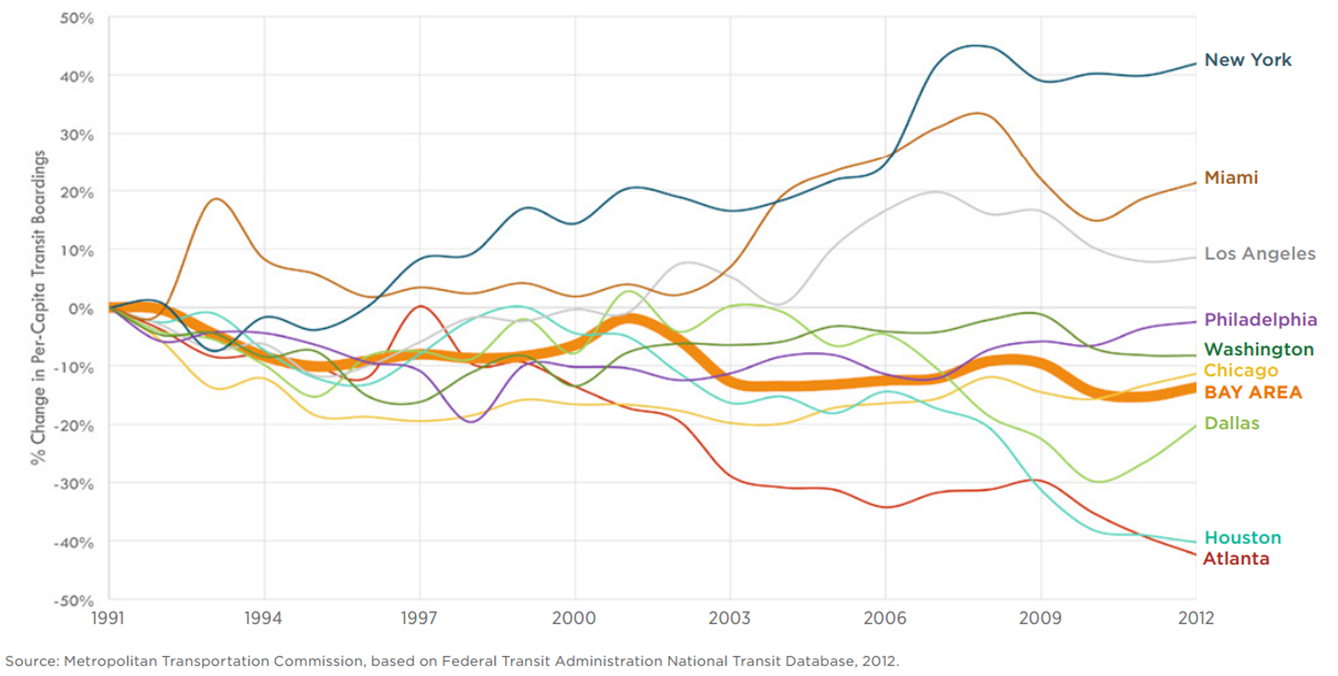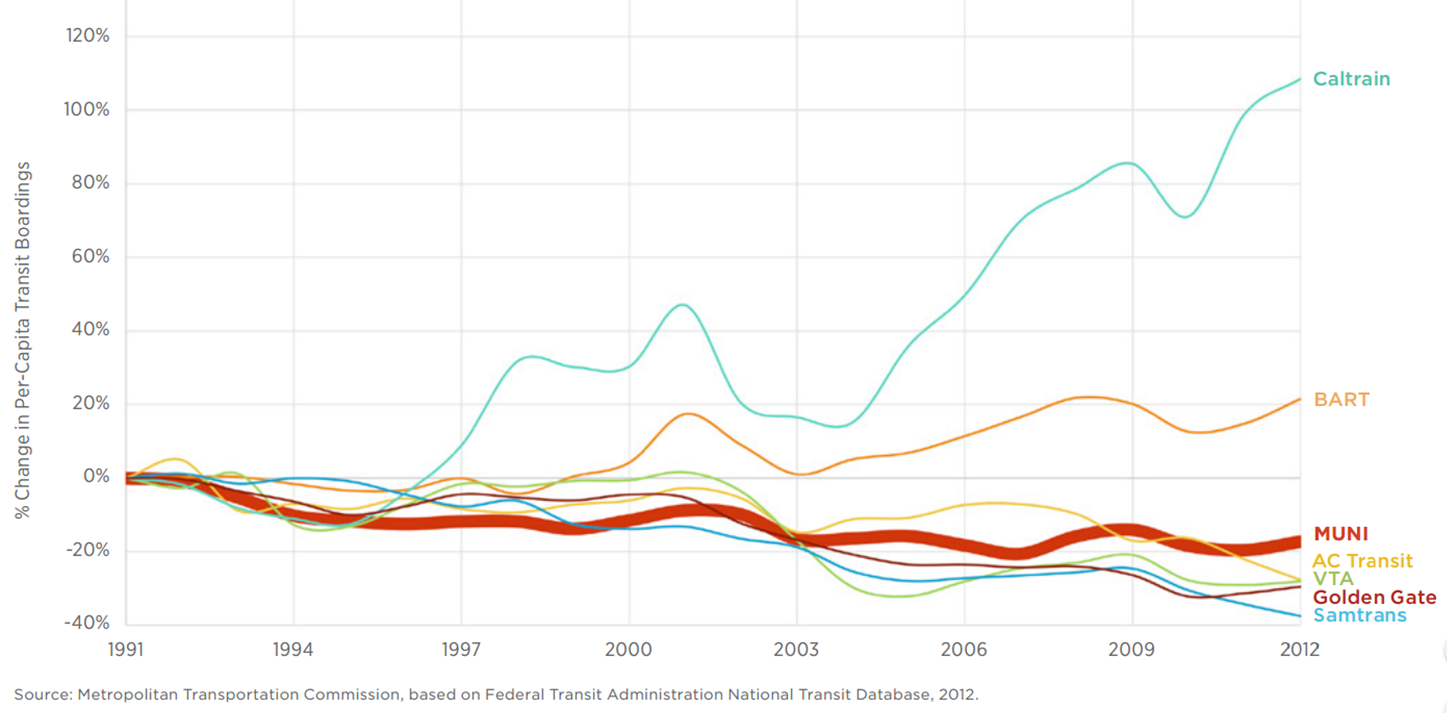The East West Connector will be ineffective
In addition to problems that are specific to the East West Connector design, there are also several more general problems that will make the East West Connector ineffective at relieving congestion. To the contrary, as shown by our county’s own traffic projection, the EWC will significantly worsen traffic in our area. The main reasons for that are described below:
1. The true goal of the East West Connector is to open up more land for car-dependent development
The EWC will not be effective at relieving traffic congestion, because that is not the reason for building it. The true reason for building this highway is to open up more land for development. Approximately 400 car-dependent houses are already proposed along Segment B of the East West Connector, but density will likely be increased and there is space for more in the field by the Old Alameda Creek. Since these areas are outside the half-mile radius of the BART station the new residents will depend on their cars for most trips. The Station District around the BART station, on the other hand, has space for 2,000 new homes, while already offering access to BART and eventually also to Dumbarton Rail. That area should be the focus of development. Unfortunately, constructing the 90 ft wide Segment C right by the Station District will undermine walkability, bike use and transit use in that area. In addition, Segment C runs straight into the hills of Union City, which has been in the cross hair of developers for a long time. By providing highway access to the hills, developers are inching one step closer to their goal. If viewed in combination with plans to widen Niles Canyon Road, it also exposes the county’s plans to get more people to locate in Pleasanton and Livermore and drive through our towns on their way to the Peninsula. The over-sized East West Connector facilitates accelerated sprawl.
2. CALTRANS itself admits: Building new roads creates new traffic
The California Department of Transportation acknowledges that building more highways does not relieve congestion. It only creates more traffic (link). Specifically, a policy brief published on California’s Department of Transportation homepage and summarizing a large body of scientific studies states:
“Capacity expansion leads to a net increase in Vehicle Miles Traveled (VMT), not simply a shifting of VMT from one road to another. A capacity expansion of 10% is likely to increase VMT by 3% to 6% in the short-run and 6% to 10% in the long-run.”
In other words, the East West Connector will immediately lead to an increase in total traffic in our area. According to the DOT policy brief, road expansion quickly induces demand for the new road through behavioral changes, such as people choosing to drive more frequently, live farther from work and choose driving over alternative modes of transportation. These behavioral changes immediately neutralize between one third and two thirds of the added capacity. In the long run, traffic in our area will have doubled. Decoto Rd will have just as much traffic as before and the East West Connector will be similarly congested. The reason is that new housing developments must take access to transportation into consideration. New construction along congested roads is more difficult to get approved. New construction will thus flock to where road capacity was added.
In the short run, it is doubtful whether there is even a marginal temporary relief in congestion. Even if this were to be the case, we would pay up front through delays during the construction phase. In the long run, nothing good comes out of this road. While there is no benefit, we pay into eternity through the permanent and irreversible damage to quality of life in our area.
You can download the whole report at http://www.dot.ca.gov/newtech/researchreports/reports/2015/10-12-2015-NCST_Brief_InducedTravel_CS6_v3.pdf
3. WAZE will Divert Traffic from I-237 and the San Mateo Bridge into our Neighborhoods
The study referred to above was conducted before smart phone apps, such as WAZE and Google Traffic were widely used. These smart phone apps provide virtually real-time route updates to drivers to enable them to pick the fastest route, taking real-time traffic conditions into consideration. These apps now guarantee that traffic is universally bad as any open space on any road is immediately identified as an opportunity to reroute tons of drivers. Even residential neighborhood streets are now at the mercy of cut-through traffic. Because of the widespread use of these apps, it is expected that the added capacity from the EWC will be instantaneously neutralized as legions of drivers are sent our way. To understand the true impact, one only needs to remember that thousands of people who live South of us have the choice between taking I-237 and the Dumbarton bridge. Similarly, thousands of people North of us daily choose between the San Mateo Bridge and the Dumbarton Bridge, depending on what Waze or Google Traffic recommends. The East-West Connector will disturb the current equilibrium and send more of those drivers our way. It will induce more drivers to prefer the Dumbarton Bridge, bringing more traffic to our neighborhoods than ever before. Instantly!
4. Since the Root Cause of our Problem is the severe Job-Housing Imbalance, a new road will not help
There is no shortage of roads, highways and freeways in the bay area. Compared to other metropolitan areas we have an abundance of large roadways. I-880, for example, is one of the widest freeways in the country. So why is this not solving our problems? Why does the I-880 mega freeway need Mission Blvd as a bypass?
The congestion of our roads is first and foremost the result of a severe job-housing imbalance across the bay, which forces people to drive long distances. It is the distances that East Bay residents have to drive to reach a job center that cause congestion, not a lack of roads. Not surprisingly, the Census Bureau has ranked the Fremont-Oakland-San Francisco area number 1 in the country for “megacommuting”, meaning it has the largest number of commuters who drive more than 50 miles to work (link). While the Peninsula is building commuter cities, with plenty of jobs but no affordable housing, the East Bay is building job-less bedroom communities. No amount of pavement can make up for this imbalance and the fact that our county wants to accommodate such a doomed setup by paving over our neighborhoods and parks is frightening, especially in an age of global warming and almost daily “Spare the Air” alerts. The root-cause of our problems is a failure to attract employers to the East Bay and any solution that is in denial about this fact will ultimately fail. There is simply no way to make a commute from Livermore to Palo Alto bearable, not in an area that has 7.1 million residents.
5. The Automobile is a great Mode of Transportation, except when 7 million people around you use it too
The automobile is a great mode of transportation but its fatal flaw is that it becomes less effective the more people use it. Put differently: Cars are not Mass Transit and attempting mass transit with cars does not work well! Contrast this to public transportation, which becomes more effective the more people use it. As ridership increases, buses and trains run more frequently and more routes can be added. Unfortunately, the bay area has one of the most underdeveloped transit systems in the nation. While cities like New York, Miami and even L.A. have increased per capita mass transit ridership since the 1990s, the bay area has lost 15% over the same time period (with increasing ridership on Caltrain and BART more than offset by dismal performance of VTA, AC Transit and Samtrans). However, instead of addressing the lack of cooperation between our 25 different transit agencies and committing to fix our mass transit system, we respond by doubling down on a single saturated mode of transportation, the car. As a result, we are the second most congested area in the country. As long as residents allow Caltrans to just build more highways, even when the cost to local communities is high, there will be no incentive to diversify into other modes of transportation. We need to say enough is enough and demand alternatives.


6. Our city layouts are too hostile to pedestrians and bicyclists, forcing everybody into their cars
A significant part of morning traffic is caused by parents dropping off their children at school. As it would be too risky to let them walk or ride their bikes, parents opt to drive them. This situation is exacerbated as overloading due to rampant development has increased the distances our students have to travel. Similarly, people who would like to use public transit have no safe way of getting to the nearest stop by bicycle or foot. They have to drive and often compete for a limited number of parking spots. Once in their cars, people thus usually drive all the way. By building more 4 and 6 lane highways through our neighborhoods, we kill walkability and bikeability. People are virtually forced into their cars, creating more traffic.
